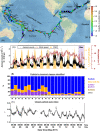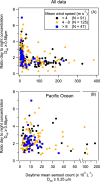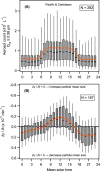Diel cycle of sea spray aerosol concentration
- PMID: 34531381
- PMCID: PMC8445914
- DOI: 10.1038/s41467-021-25579-3
Diel cycle of sea spray aerosol concentration
Abstract
Sea spray aerosol (SSA) formation have a major role in the climate system, but measurements at a global-scale of this micro-scale process are highly challenging. We measured high-resolution temporal patterns of SSA number concentration over the Atlantic Ocean, Caribbean Sea, and the Pacific Ocean covering over 42,000 km. We discovered a ubiquitous 24-hour rhythm to the SSA number concentration, with concentrations increasing after sunrise, remaining higher during the day, and returning to predawn values after sunset. The presence of dominating continental aerosol transport can mask the SSA cycle. We did not find significant links between the diel cycle of SSA number concentration and diel variations of surface winds, atmospheric physical properties, radiation, pollution, nor oceanic physical properties. However, the daily mean sea surface temperature positively correlated with the magnitude of the day-to-nighttime increase in SSA concentration. Parallel diel patterns in particle sizes were also detected in near-surface waters attributed to variations in the size of particles smaller than ~1 µm. These variations may point to microbial day-to-night modulation of bubble-bursting dynamics as a possible cause of the SSA cycle.
© 2021. The Author(s).
Conflict of interest statement
The authors declare no competing interests.
Figures






References
-
- Flores JM, et al. Tara Pacific expedition’s atmospheric measurements of marine aerosols across the Atlantic and Pacific Oceans: overview and preliminary results. Bull. Am. Meteorological Soc. 2020;101:E536–E554. doi: 10.1175/BAMS-D-18-0224.1. - DOI
-
- D. A. Gillette, “Environmental Factors Affecting Dust Emission by Wind Erosion,” In: C. Morales, Ed., Saharan Dust, Scope 14, John Wiley & Sons, New York, 1979, pp. 71–91.
-
- Lewis, R. & Schwartz, E. Sea Salt Aerosol Production: Mechanisms, Methods, Measurements and Models—a Critical Review Vol. 152 (American Geophysical Union, 2004).
-
- de Leeuw, G. et al. in Ocean-Atmosphere Interactions of Gases and Particles (eds. Liss, P. S. & Johnson, M. T.) 171–246 (Springer Berlin Heidelberg, 2014).
Publication types
LinkOut - more resources
Full Text Sources
Research Materials

